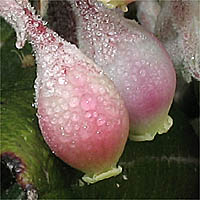Mission Manzanita
Xylococcus bicolor
Family: Ericaceae (HEATH).
Generic common name: MISSION MANZANITA.
Location: Deer Creek Canyon, coastal sage scrub, March 2023.
Characteristics: Native, White, Red, Small, Medium, Clusters, Simple, Woody, Perennial, Winter, Early Spring.
Most of the photos shown here are from the Cabrillo National Monument, 2009.










